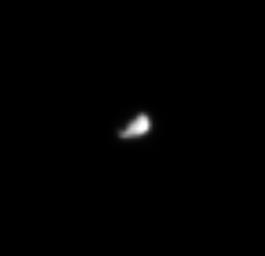Day and Night on Hyperion
Caption:
As it approached Saturn near the end of its second orbit, Cassini caught this view of the small, irregularly shaped moon Hyperion (266 kilometers, or 165 miles, across). The moon's long axis is nearly horizontal in this view. The image shows parts of Hyperion's day and night sides.
Hyperion is a heavily cratered body, though Cassini's cameras were not able to discern much detail from the distance at which the image was taken. The spacecraft is slated to fly past the little moon at an altitude of less than 1,000 kilometers (620 miles) in late 2005, compared with a distance of 5.9 million kilometers (3.7 million miles) between Hyperion and Cassini when this image was taken.
The image was taken in visible light with the Cassini spacecraft narrow angle camera on Sep. 29, 2004, at a Sun-Hyperion-spacecraft, or phase, angle of 75 degrees. The image scale is 35 kilometers (22 miles) per pixel. The image has been magnified by a factor of four to aid visibility.
Background Info:
The Cassini-Huygens mission is a cooperative project of NASA, the European Space Agency and the Italian Space Agency. The Jet Propulsion Laboratory, a division of the California Institute of Technology in Pasadena, manages the Cassini-Huygens mission for NASA's Office of Space Science, Washington, D.C. The Cassini orbiter and its two onboard cameras, were designed, developed and assembled at JPL. The imaging team is based at the Space Science Institute, Boulder, Colo.
For more information, about the Cassini-Huygens mission visit,
http://saturn.jpl.nasa.gov
and the Cassini imaging team home page,
http://ciclops.org
.
Cataloging Keywords:
| Name |
Value |
Additional Values |
| Target |
Hyperion |
Saturn |
| System |
Saturn |
|
| Target Type |
Satellite |
Planet |
| Mission |
Cassini-Huygens |
|
| Instrument Host |
Cassini Orbiter |
|
| Host Type |
Orbiter |
|
| Instrument |
Imaging Science Subsystem (ISS) |
|
| Detector |
Narrow Angle Camera |
|
| Extra Keywords |
Crater, Grayscale, Visual |
| Acquisition Date |
|
| Release Date |
2004-10-22 |
| Date in Caption |
2004-09-29 |
|
| Image Credit |
NASA/JPL/Space Science Institute |
| Source |
photojournal.jpl.nasa.gov/catalog/PIA06504 |
| Identifier |
PIA06504 |

 Planetary Data System
Planetary Data System
